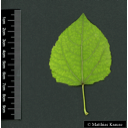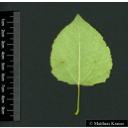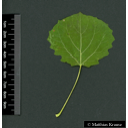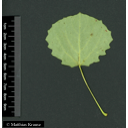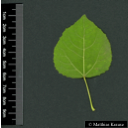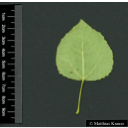Useful information about the taxon (species, subspecies, variety...)
Populus tremula L. 1753
Salicaceae
(APG IV)European aspen, Eurasian aspen, Quaking aspen
Taxon concept: The Plant List (2014), version 1.1
Distribution: Europe; Turkey, Levante, Caucasus, Russia: west and east Siberia, Amur, Sachalin, Kamchatka, Central Asia, Mongolia, Korea, Japan, China; Algeria
Populus tremula L. - Accepted: Populus tremula L. bei Zander 2008; Familie: Salicaceae (Zander 2008)Populus tremula L. - Accepted: Populus tremula L. bei The Plant List (2010); Familie: Salicaceae (APG III)Populus tremula L. - Accepted: Populus tremula L. bei The Plant List (2014), version 1.1; Familie: Salicaceae (APG III)Populus tremula L. - Accepted: Populus tremula L. bei Schmeil-Fitschen 2019; Familie: Salicaceae (APG III)Populus tremula L. - Accepted: Populus tremula L. bei BfN Checklist Flora DE; Familie: Salicaceae (APG IV)Populus tremula L. - Accepted: Populus tremula L. bei World Flora Online - APG IV (Angiosperms); Familie: Salicaceae (World Flora Online - APG IV (Angiosperms))
- Flowers
- dioecious tree
- Flower ecology
- wind-pollinated (anemophilous)
- Life form
- woody, tree
- Foliage persistence
- deciduous
- Fruits
- capsule fruit contains numerous tiny seeds
- Fruit ecology
- wind-dispersed (anemochorous)
- Soil conditions
- preferentially on ground or perculating fresh, nutrient-rich and alkaline, sandy, loess containing, and loamy soils
- Light conditions
- light-demanding
- Succession type
- forest pioneer
- Natural occurrence (habitat)
- pollarded and pioneer woodlands, scrub (e.g. with hawthorn), mixed forests, Norway spruce forests, oak woodlands, beech forests, sparse forests, forest edges, hedgerows, blockfields; rocks; from lowland to highland
- Vegetation typ and synecology (plant community)
- temperate, mesophytic broad-leaved and mixed forests to boreal forests; in associations of the Sambuco-Salicion, also in Prunetalia associations
- Natural propagation (all types)
- vegetative reproduction by root suckers
- General recommendation
- recommended for beekeeping
- Bark
- greenish-grey bark with diamond-shaped lenticels
Breunig, T. et al. (2021): Rote Liste der Farn- und Blütenpflanzen Baden-Württembergs.; Bundesamt für Naturschutz (BfN) (1999-2001 and ongoing): Floraweb - Daten und Informationen zu Wildpflanzen und zur Vegetation Deutschlands. www.floraweb.de.; Haider, M. et al. (2005): Wildbienenkataster. See: https://www.wildbienen-kataster.de; Maurizio, Anna et al. (1982): Nektar und Pollen - die wichtigsten Nahrungsquellen der Honigbiene. 4. Ehrenwirth, München, 3, überabeitete Auflage; Metzing, D. et al. (2018): Rote Liste und Gesamtartenliste der Farn- und Blütenpflanzen (Trachaeophyta) Deutschlands .; Oberdorfer, E. (2001): Pflanzensoziologische Exkursionsflora. Für Deutschland und angrenzende Gebiete. Eugen Ulmer Verlag, Stuttgart, 8., stark überarb. u. erg. Aufl, 1056 S. 978-3-8001-3131-0.; Pritsch, Günter et al. (1985): Bienenweide.. Neumann-Neudamm, Melsungen; Schick, B. & Spürgin, A. (1997): Die Bienenweide. Eugen Ulmer Verlag, Stuttgart, Auflage: 4., völlig neubearb. u. erw. A., 216 S. 978-3800174188.; The International Plant Names Index (2009). Published on the Internet http://www.ipni.org; Courtesy to IPNI, 2009. Exported from IPNI at date: 2009-09-22 20:17:51; Westrich, P. et al. (2018): Die Wildbienen Deutschlands.. Ulmer Verlag ISBN 978-8186-0123-2.;
Diese Webseite verwendet Google Maps, um Karten und Standorte von Pflanzen in den Hohenheimer Gärten anzuzeigen. Dadurch werden unter Umständen Daten an Google weitergeleitet, was mit einer Verarbeitung Ihrer personenbezogenen Daten verbunden sein kann. Die Datenschutzerklärung von Google finden Sie hier: Datenschutzerklärung von Google
| Sex | Standort | Accession number | Planting year | Donation | IPEN | Lat. | Long. |
|---|---|---|---|---|---|---|---|
| Parzelle Z | LG-Z-097-5466 | 2002 | + | XX-0-HOH-LG-Z-097-5466 | 48,7048953648 | 9,2125906625 |

